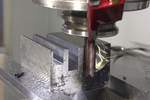Milling Line Offers Plunging, Ramping Capabilities
Kyocera SGS Precision Tools highlights its Z-Carb XPR end mill line with plunging and ramping capabilities to enable more aggressive tool paths and a wider variety of roughing and finishing techniques while still maintaining precision and durability.

Source | Kyocera SGS Precision Tools
Kyocera SGS Precision Tools highlights its Z-Carb XPR end mill line with plunging and ramping capabilities. These cutters enable machinists to utilize more aggressive tool paths and use a wider variety of roughing and finishing techniques while still maintaining precision and durability.
The Z-Carb XPR is designed to excel in advanced axial workpiece entry techniques, including plunging, ramping and helical interpolation, thanks to its unique end teeth design. This innovative feature, combined with completely variable geometry, enables for increased speeds and feeds while minimizing chatter and resonant vibrations, resulting in smoother and more efficient machining operations.
Its universal geometry makes it suitable for use across a wide range of material groups, providing versatility in various applications and delivers excellent performance in slotting, advanced roughing, general roughing, semi-finishing and finishing operations.
The company offers two standard coatings developed to protect tool life. Kyocera’s proprietary Megacoat Nano coating technology features nano-layers for wear resistance and high oxidation resistance that enables for operation at high temperatures. The layered structure also gives the coating the toughness required to resist chipping. Megacoat Nan is particularly effective in high efficiency machining applications. The Ti-NAMITE-X coating handles a diverse range of applications from high- and low-alloy steels to hardened materials and is suitable for operations which require high cutting speeds, high temperatures at the cutting edge and high metal removal rates.
Related Content
-
It Starts With the Part: A Plastic Part Checklist Ensures Good Mold Design
All successful mold build projects start with examining the part to be molded to ensure it is moldable and will meet the customers' production objectives.
-
Revisiting Some Hot Runner Fundamentals
What exactly does a hot runner do? If you’ve been in the injection molding industry for any length of time, you might think the answer is obvious, but it is not.
-
Machining Center Spindles: What You Need to Know
Why and how to research spindle technology before purchasing a machining center.







.png;maxWidth=300;quality=90)





